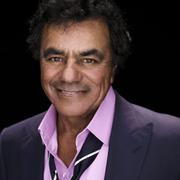Johnny Mathis
永恒的情歌大师Johnny Mathis带来10首诠释经典歌曲的最新专辑。收录第47届格莱美最大赢家Ray Charles与Johnny Mathis的合唱歌《Over The Rainbow》。 上一个世纪50年代以来,Johnny Mathis的歌便伴随着无数进去,从唱片、广告、电视、电影的传送而深入人心。这个曾经缔造停留Billboard排行榜最佳销售榜达9周之久的纪录,并有26张销售金唱片与白金唱片佳绩的常青树,2005年全新专辑《Isn't It Romantic: The Standards Album》,有格莱美奖得主Jorge Calandrelli负责编曲制作,完美地呈现Johnny Mathis历久弥新的歌喉与无与伦比的情歌风格。 专辑曲目: 1. Isn't It Romantic 2. Love Is Here To Stay 3. Day By Day 4. Dindi 5. There's A Kind Hush 6. This Can't Be Love 7. Cottage For Sale 8. Almost Like Being In Love 9. The Rainbow Connection 10. Over The Rainbowby John BushOne of the last and most popular in a long line of traditional male vocalists who emerged before the rock-dominated 1960s, Johnny Mathis concentrated on romantic readings of jazz and pop standards for the ever-shrinking adult contemporary audience of the '60s and '70s. Though he debuted with a flurry of singles-chart activity, Mathis later made it big in the album market, where a dozen of his LPs hit gold or platinum and over 60 made the charts. While he concentrated on theme-oriented albums of show tunes and traditional favorites during the '60s, he began incorporating soft rock by the '70s and remained a popular concert attraction well into the '90s.Unsurprisingly, given his emphasis on long sustained notes and heavy vibrato, Johnny Mathis studied with an opera coach prior to his teenage years, and was almost lured into the profession; his other inspirations were the smoother crossover jazz vocalists of the 1940s -- Nat "King" Cole, Billy Eckstine, and Lena Horne. Mathis was an exceptional high school athlete in San Francisco, but was wooed away from a college track scholarship and a potential spot on the Olympic squad by the chance to sing. He was signed to a management contract by club owner Helen Noga, who introduced the singer to George Avakian, jazz producer for Columbia Records. Avakian signed him and used orchestras conducted by Teo Macero, Gil Evans, and John Lewis to record Mathis' self-titled debut album in 1957. Despite the name talent and choice of standards, it was mostly ignored upon release.Columbia A&R executive Mitch Miller -- known for his desperately pop-slanted Sing Along albums and TV show -- decided the only recourse was switching Mathis to Miller's brand of pop balladry, and the formula worked like a charm; the LP Wonderful, Wonderful didn't include but was named after a Top 20 hit later in 1957, which was followed by the number five "It's Not for Me to Say" and his first number one, "Chances Are." From that point on, Johnny Mathis concentrated strictly on lush ballads for adult contemporary listeners.Though he charted consistently, massive hit singles were rare for Johnny Mathis during the late '50s and '60s -- half of his career Top Ten output had occurred in 1957 alone -- so he chose to focus instead on the burgeoning album market, much like Frank Sinatra, his main rival during the late '50s as the most popular traditional male vocalist. Mathis moved away from show tunes and traditional pop into soft rock during the '70s, and found his second number one single, "Too Much, Too Little, Too Late," in 1978. Recorded as a duet with Deniece Williams, the single prompted Mathis to begin trying duets with a variety of partners (including Dionne Warwick, Natalie Cole, Gladys Knight, and Nana Mouskouri), though none of the singles enjoyed the success of the original. Mathis continued to release and sell albums throughout the '90s -- his fifth decade of recording for Columbia -- among them 1998's Because You Loved Me: Songs of Diane Warren and 2000's Johnny Mathis on Broadway.


 Gina - Johnny Mathis
Gina - Johnny Mathis




























![[STATION] aespa《Dreams Come True》MV Teaser - aespa (에스파)](https://img2.kuwo.cn/wmvpic/324/79/54/2120387380.jpg?imageView2/1/w/195/h/130/format/jpg/q/60)





